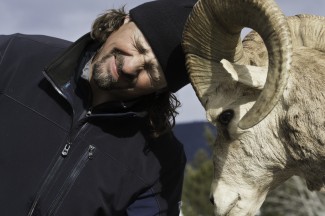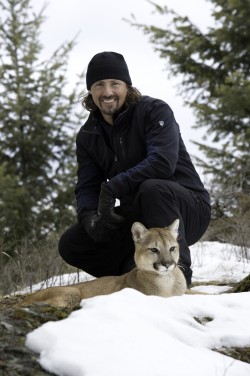INTERVIEW: Casey Anderson explores bats, bears, mountain lions on ‘America the Wild’

Casey Anderson is probably quite tired. The host of Nat Geo Wild’s America the Wild, which premieres new episodes Sundays at 10 p.m., has spent the last year tracking down and filming some of the most revered animal species in North America. From colonies of bats to elusive mountain lions, Anderson is a man enjoying what the United States has to offer.
“I’m super excited,” Anderson said recently during a phone interview. “I literally spent nearly a year out there in various places, you know, creating all this content that turns into a show, and it’d be a shame not to be able to share it. So here’s my moment to shine. I can’t be more excited.”
The process of filming America the Wild is a complicated one. Anderson’s small team needs to catch these animals in their wild habitats, and unpredictable animals can be, well, unpredictable. The nature series is appropriately titled. This is not America the Zoo.
“I try to look at wildlife issues or some kind of event that’s happening out there in America,” Anderson said of how he chooses the different species to highlight. “So I have to schedule a year of production, and often a lot of them are overlapping, so I can’t be at the same place at the same time. So I have to kind of pick and choose what’s lying around. So in the six hours you’ll see this season, it literally took from August to August to create it. So it is a complicated scheduling process in the very least. When you go out there you never know that it’s going to happen. It’s not guaranteed. Wildlife certainly is unpredictable. So you try to pick the most predictable situations and then immerse yourself in the middle of it and see what happens.”
For this season of America the Wild, Anderson said his schedule actually turned up many surprises. All species he wished to document were present and accounted for; they even exceeded his high expectations. “This year we covered bats, which is … an animal I knew nothing about,” he said. “It’s an animal usually people are trying to avoid. And I went and did this investigation about bats, particularly vampire bats. As the climate changes, they are moving north and could potentially be in the United States within a decade. So I want to know what is a vampire bat, what does it really do — literally going out there, hanging out with them, finding them in the wild. One night spending a night in the fields with a bunch of cattle who are being fed upon by these bats, and literally laying out there with these cows and giving them the opportunity for me to be on the menu. Well, I won’t tell you what happened exactly.”

Anderson said he walked away from these vampire bats with a newfound respect and understanding for the species. He replaced fear and terror with an educational encounter.
In addition to bats, Anderson’s crew also caught up with mountain lions, big horn sheep and moose. The TV host was actually charged by a moose twice in one day, a tough job for someone who who works with a couple camera operators and needs to lug around a backpack weighing up to 90 pounds of camera equipment.
Perhaps the ultimate highlight of the new season is when Anderson headed out at night to catch grizzly bears in their natural habitat. Anderson has a history with grizzlies, helping found the Montana Grizzly Encounter, a sanctuary for rescued bears that cannot be released into the wild. So shooting this episode of America the Wild was somewhat familiar to him.
“I’m going to go out there at night with grizzly bears using this cool technology, thermal imagery, infrared lighting, to go out there and see behavior that’s never been seen before, I mean really in that National Geographic spirit. … Yeah, bears are obviously one of my biggest fascinations, and I understand them probably the best of all the animals I covered this season. But at night I do know that bears often they get in trouble at night. They do the things that they shouldn’t be doing, you know, coming to the campgrounds or interacting with humans in a way that we don’t like. So having that knowledge actually didn’t necessarily make me more comfortable; it made me a little more weary.”
America the Wild, a nature program with a host rather than a nature program with an ominous narrator, is an immersive experience. Anderson called it “experiential,” an opportunity to bring the viewers along for a ride.
“I think when you experience something that way, when you’re kind of immersed in that, and you get to feel the wild, I think it just connects to you a little deeper,” he said. “And I think if you have that connection, that same connection that fuels my passion for the wild, then you want to do something to take care of it. You want it to stick around. You don’t fear the unknown. The unknown becomes part of your life. It’s your playground. And that’s what I want. That’s what I try to achieve, and I think the show really does do that.”
Anderson has had a love for the wild since growing up as a young boy in Montana. He has fond memories of flipping over logs and rocks to find critters with his ever-inspecting eyes. In middle school, he had a rattlesnake as a pet, and at 19 years old he was first introduced to wildlife filmmaking. “And I realized that, you know, here is the greatest soapbox you can have in the entertainment world and the TV world to get out there and spread the word,” he said. “I realized I have the abilities and the responsibility to share that stuff. And that was the only way that it would remain is by sharing and recruiting people and their hearts and minds for the wildlife.”
One of Anderson’s most intimate wildlife encounters was with a grizzly bear called Brutus, who now lives at Montana Grizzly Encounter. The now 11-year-old bear has become a special project for Anderson, and the TV host loves coming back to his home state to check in on his friend’s progress.
“As I’m running around the world chasing around bats and moose, he remains as a bear at the sanctuary with his other bear friends 99 percent of the time. But that other 1 percent, he does interact with me. They’re smarter than dogs, more emotional than dogs, so he doesn’t forget me by any means. But … a dog is an animal who needs companionship. They’re a pack animal, they need it constantly. A bear, a grizzly bear, you know, they’re pretty anti-social. They live their life on the solo level quite a bit. He’s a bear, I respect that. He’s a grizzly bear, and if he interacts with me a little bit, that’s cool. So yeah I get to see him when I get home. I go over and say hi. It’s funny, the older he gets, he’s like, hey guy, the guy that I like and know and raised me, but then he’s like I’m going to wrestle around with the other bears and live my bear life. So I respect that, and that’s cool. He’s kind of got the best of both worlds.”
After spending time with Brutus, it’s back to the wilds of America for Anderson, back to his TV audience.
“You build a rapport I think with your audience, a friendship of sorts,” he said. “For me to go out there and investigate, come up with a way for everybody to help out, to save wildlife, to save wild places, I hope that I can continue to do it.”
By John Soltes / Publisher / John@HollywoodSoapbox.com
-
Click here for more information on America the Wild.

